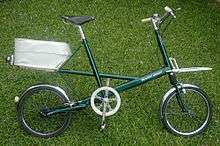Small wheel bicycle

Small wheel bicycles are adult bicycles which have wheels of 20 inch nominal diameter or less, which is smaller than the 26", 27.5", 29" or 700c sizes common on most full-sized adult bikes. While many folding bicycles are small wheel bicycles, not all small wheel bicycles can fold. Some small wheel bicycles neither fold nor separate, such as the Moulton, which comes in both fixed frame and separable frame versions. While BMX bikes also have 20" wheels, they are not normally categorised as "small wheel bikes".
For general information on small wheel folding bikes, please refer to the Folding bicycle and Portable bicycle articles.
For specific manufacturers, follow the categories links.
History
An early proponent of small-wheeled adult bicycles was Paul De Vivie, better known by his pen name "Velocio". His approach was to use a balloon-width tire of about 2.25" (57mm) on a 20" (500mm) rim, giving a wheel of approximately 24" (600mm) in diameter.[1]

The man credited with being the father of modern small-wheel bicycles is Alex Moulton who pioneered the field with his F-framed Moulton Bicycle in 1962. His original small-wheeled design notably featured full suspension. Raleigh introduced the RSW-16 as a direct competitor, but it lacked the suspension of the Moulton, and compensated for this by using very wide 2-inch "balloon" tires. The RSW-16 "Compact" was a folding version. In 1968 Raleigh introduced the Raleigh Twenty which later went on to become one of Raleigh's biggest sellers. A large number of European manufacturers made U-frame small-wheeled and folding bicycles in the 1970s.
Advantages and disadvantages
Smaller wheels are more maneuverable.[2] For this reason, and in some cases for comic effect, they are used in some clown bicycles. Smaller wheels more faithfully follow the terrain, giving a harsher ride on bumpy roads that are effectively smoothed by larger ones.[2] It may be desirable for bicycles with smaller wheels to also be fitted with some form of suspension to improve riding characteristics. Bicycles with small wheels normally have their gearing adjusted to provide the same effective wheel radius as large ones, so pedalling cadence is not different. Smaller wheels tend to weigh less than larger ones, thus bringing the performance benefits of light wheels.
Small wheels, all else being equal, have slightly higher rolling resistance.[3] On the other hand, they may have lower aerodynamic drag due to their smaller area which is proportional to their radius.
See also
- Birdy (bicycle)
- Brompton Bicycle
- Folding bicycle
- Moulton Bicycle
- Portable bicycle
- Strida
- List of bicycle manufacturing companies
- Outline of cycling
References
- ↑ De Vivie, P. (writing as "Vélocio"), Le Cycliste, France, 1911. (French original provided by Raymond Henry. English translation commissioned by Tony Hadland.)
- 1 2 Lennard Zinn (1999). Mountain Bike Performance Handbook. p. 72. ISBN 978-0-933201-95-8.
- ↑ Hibbeler, R.C. (2007). Engineering Mechanics: Statics & Dynamics (Eleventh ed.). Pearson, Prentice Hall. pp. 441–442.
External links
- Usenet quote: "A larger wheel rides better on average roads and always corners better because it brings a longer contact patch to the road." Mechanical engineer Jobst Brandt on optimal wheel sizes